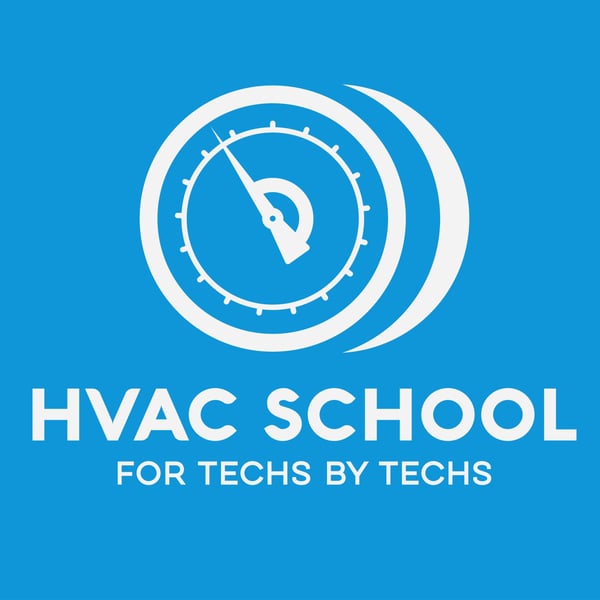Hard Shut Off TXVs
HVAC School - For Techs, By Techs
Bryan Orr
4.8 • 985 Ratings
🗓️ 23 August 2018
⏱️ 43 minutes
🧾️ Download transcript
Summary
Jamie Kitchen returns to the podcast and talks all about hard shut off TXVs/TEVs. He discusses bleed and non-bleed valves and why the TXV type matters to your compressor.
When it comes to TXVs, there are two main types: bleed and non-bleed. The former may be referred to as a bleed TXV, and the latter may simply be called a TXV. However, OEMs may refer to TXVs as a "hard shut off TXV" (HSO), which is a non-bleed TXV.
The core difference between bleed and non-bleed TXVs is the equalization speed. That equalization speed affects how your compressor runs; equalizing the system reduces the pressure differential that the compressor will have to overcome on startup. Non-bleed/hard shut off TXVs may cause the compressor to draw locked rotor amps because the pressures did not equalize. To mitigate that issue, you can put in a start cap and relay on the compressor or replace the valve with a bleed TXV.
The main purpose of hard shut off TXVs is to prevent refrigerant migration and flooded starts when the system is off. The non-bleed TXV does not permit equalization, which builds pressure and but keeps refrigerant in the condenser, not the evaporator. Although the compressor will have to overcome more pressure upon startup, it will be less likely to fail due to a flooded start. However, some manufacturers may recommend using a hard start kit to overcome that pressure if you use a hard shut off TXV (even on scroll compressors!).
Jamie and Bryan also discuss:
- Non-bleed TXVs on scroll compressors
- Pressure rising and falling throughout the system
- Opening/closing forces
- Superheat spring
- Liquid refrigerant migration
- Shutting off the suction line vs. using a liquid line solenoid valve
- Proper equipment sizing and short-cycling
- Charging with bleed vs. non-bleed TXVs
- Energy benefits
Learn more about Refrigeration Technologies HERE.
Transcript
Click on a timestamp to play from that location
| 0:00.0 | and This episode of the HVAC School Podcast is made possible by our fantastic sponsors, |
| 0:21.4 | Carrier and Carrier. carrier. |
| 0:23.3 | One thing you should know about carrier is they have this new |
| 0:25.4 | duckless dealer program where they're really trying to take |
| 0:28.1 | duckless seriously. |
| 0:28.8 | I've been really impressed with some of the hires |
| 0:30.9 | that carriers made recently in the Duckless Division. Jonathan Jones, |
| 0:34.4 | you've heard on the podcast in the past, talking about de-humidification. |
| 0:36.9 | He's now doing some training for them down in Atlanta. |
| 0:39.7 | They're building a really nice facility there and just some good stuff going on at carrier especially |
| 0:43.6 | on the ductless side. So find out more by going to carrier.com. |
| 0:47.2 | Our friends at refrigeration technologies at refrigetech.com, John and Mike Pasterllo, really good guys. |
| 0:53.0 | Contributors to the podcast, guys who have really helped me make this podcast possible and have helped make some great products along the way that we've used at my business, |
| 1:01.0 | including the Viper Cleaner. They sell Viper Cleaner in a gallon |
| 1:04.7 | jug that you can use with a foaming sprayer or you can also buy the aerosol cans |
| 1:09.7 | which are great |
| 1:13.2 | great, especially if you're doing a coil clean in place or blower wheel, something like that. |
| 1:13.8 | Also, the pan and drain spray, which is a great replacement for pan tabs. |
| 1:17.8 | Nylog, the assembly lubricant, and thread sealant, |
| 1:21.1 | and then the ubiquitous big blue that you see in the big blue |
| 1:24.3 | bottles and they also have them in the little swab containers. If you don't see |
| 1:27.5 | refrigeration technologies at your local supply house, ask them to consider |
... |
Please login to see the full transcript.
Disclaimer: The podcast and artwork embedded on this page are from Bryan Orr, and are the property of its owner and not affiliated with or endorsed by Tapesearch.
Generated transcripts are the property of Bryan Orr and are distributed freely under the Fair Use doctrine. Transcripts generated by Tapesearch are not guaranteed to be accurate.
Copyright © Tapesearch 2025.

